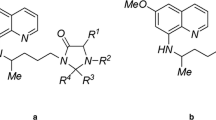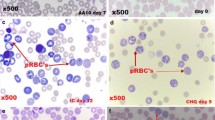Summary
The disposition of a single 80 mg/kg injection of quinine base was compared in control andPlasmodium berghei-infected mice. Pharmacokinetic parameters were determined on repeated whole blood samples from caudal vein (experiment 1) and quinine distribution was evaluated in tissues and blood fractions from mice sacrificed two hours post dosing (experiment 2). Quinine concentrations were assessed by high performance liquid chromatography with fluorometric detection. Whole blood concentrations and AUC0−∞ of quinine increased in a parasitaemia-dependent manner. Quinine blood clearance and peak blood concentrations of metabolites negatively correlated with the parasitaemia. The apparent distribution volume of quinine only decreased in severely ill mice.
Quinine concentrations rise in a parasitaemia-dependent manner in homogenates of spleen, lungs and kidney and in erythrocyte pellets. The negative relationship, observed between the parasitaemia and the tissue-to-whole blood ratio for muscle, heart, liver and brain, contributes to the reduction of the blood distribution volume. Quinine uptake by muscle and heart was dependent on the free fraction of plasma quinine. The liver and brain concentrations of quinine were similar in control and infected mice. The tissue-to-plasma free fraction ratios decrease when the parasitaemia rises suggesting a restrictive uptake of quinine by these tissues. In conclusion.P. berghei malaria decreases both total clearance and apparent volume of distribution with a heterogeneous redistribution of quinine between the tissues.
Similar content being viewed by others
References
White N.J., Chanthavanich P., Krishna S., Bunch C. and Silamut K. (1983): Quinine disposition kinetics. Br. J. Clin. Pharmacol., 16, 399–403.
White N.J., Looareesuwan S., Warrell D.A., Warrell M.J., Bunnag D. and Harinasuta T. (1982): Quinine pharmacokinetics and toxicity in cerebral and uncomplicatedfalciparum malaria. Am. J. Med., 73, 564–572.
Pussard E., Barennes H., Daouda H., Clavier F., Mahaman Sani A., Osse M., Granic G. and Verdier F. (1999): Quinine disposition in globally malnourished children with cerebral malaria. Clin. Pharmacol. Ther., 65, 500–510.
Krishna S. and White N.J. (1996): Pharmacokinetics of quinine, chloroquine and amodiaquine: clinical implications. Clin. Pharmacokinet., 30, 263–299.
Emudianughe T.S., Bickle Q.D., Taylor M.G. and Andrews B. (1985): Effect ofplasmodium berghei infection on benzoic acid metabolism in mice. Experientia, 41, 1407–1409.
Mansor S.M., Edwards G., Roberts P.J. and Ward S.A. (1991): The effect of malaria infection on paracetamol disposition in the rat. Biochem. Pharmacol., 41, 1701–1711.
Mansor S.M., Ward S.A. and Edwards G. (1991): The effect of malaria infection on antipyrine metabolite formation in the rat. Biochem. Pharmacol., 41, 1264–1266.
Wilairatana P., Looareesuwan S., Vanijanonta S., Charoenlarp P. and Wittayalertpanya S. (1994): Hepatic metabolism in severefalciparum malaria: caffeine clearance study. Ann. Trop. Med. Parasitol., 88, 13–19.
Mansor S.M., Ward S.A., Edwards G., Hoaksey P.E. and Breckenridge A.M. (1990): The effect of malaria infection on the disposition of quinine and quinidine in the rat isolated perfused liver preparation. J. Pharm. Pharmacol., 42, 428–432.
Song G.H., Andre R.G., Scheibel L.W., Wirtz R.A., Cheriathundam E. and Alvares A.P. (1995):Plasmodium berghei: sensitivity of chloroquine-resistant and chloroquine-sensitive strains to irradiation and the effect of irradiated parasites on cytochrome P450-dependent monooxygenases. Res. Com. Mol. Path. Pharmacol., 90, 75–85.
Saxena N., Saxena A., Dutta G.P., Gatak S. and Pandey V.C. (1987): Effect ofPlasmodium yoleii nigeriensis infection and chloroquine on the hepatic mixed function oxidase system of mice. Mol. Biochem. Parasitol., 24, 283–287.
Pukrittayakamee S., Looareesuwan S., Keeratithakul D., Davis T.M.E., Teja-Isavadharm P., Nagachinta B., Weber A., Smith A.L., Kyle D. and White N.J. (1997): A study of the factors affecting the metabolic clearance of quinine in malaria. Eur. J. Clin. Pharmacol., 52, 487–493.
Silamut K., White N.J., Looareesuwan S. and Warrell D.A. (1985): Binding of quinine to plasma proteins infalciparum malaria. Am. J. Trop. Med. Hyg., 34, 681–686.
Peters W. (1987): Chemotherapy and drug resistance in malaria. 2nd Edition. Academic Press. London.
Thumwood C.M., Hunt N.H., Clark I.A. and Cowden W.B. (1988): Break down of the blood-brain barrier in murine cerebral malaria. Parasitology 96, 579–589.
Brown H., Hien T.T., Day N., Mai N.T., Chuong L.V., Chau T.T., Loc P.P., Phu N.H., Bethell D., Farrar J., Gatter K., White N.J. and Turner G. (1999): Evidence of blood-brain barrier dysfunction in human cerebral malaria. Neuropathol. Appl. Neurobiol., 25, 331–340.
Brown H.C., Chau T.T.C., Mai N.T.H., Day N.P.J., Sinh D.X., White N.J., Hien T.T., Farrar J. and Turner G.D.H. (2000): Blood-brain barrier function in cerebral malaria and CNS infections in Vietnam. Neurology, 55, 104–111.
Vuong P.N., Richard F., Snounou G., Coquelin F., Rénia L., Gonnet F., Chabaud A.G. and Landau I. (1999): Development of irreversible lesions in the brain, heart and kidney following acute and chronic murine malaria infection. Parasitology, 119, 546–553.
Zhao H.J. and Ishizaki T. (1997): Thein vitro hepatic metabolism of quinine in mice, rats and dogs: comparison with human liver microsomes. J. Pharmacol. Exp. Ther., 283, 1168–1176.
Iliadis A., Brown C. and Huggins M.L. (1992): Apis: a software for model identification, simulation and dosage regimens calculation in clinical and experimental pharmacokinetics. Comp. Methods Programs Biomed. 38, 227–239.
Zhang H., Coville P.F., Walker R.J., Miners J.O., Birkett D.J. and Wanwimolruk S. (1997): Evidence for involvement of human CYP3A in the 3-hydroxylation of quinine. Br. J. Clin. Pharmacol., 43, 245–252.
Liddle C., Graham G.G., Christopher R.K., Bhuwapathanapun S. and Duffield A.M. (1981). Identification of new urinary metabolites in man of quinine using methane chemical ionization gas chromatography-mass spectrometry. Xenobiotica, 11, 81–87.
Wanwimolruk S., Wong S.M., Zhang H. and Coville P.F. (1996): Simultaneous determination of quinine and a major metabolite 3-hydroxy quinine in biological fluids by HPLC without extraction. J. Liq. Chromatogr., 19, 293–305.
Bannon P., Yu P., Cook J.M., Roy L. and Villeneuve J.P. (1998): Identification of quinine metabolites in urine after oral dosing in humans. J. Chromatogr., 715, 387–393.
Muller-Eberhard U., Eiseman J.L., Foielart M. and Alvares A.P. (1983): Effect of heme on allylisopropyl acetamide induced changes in heme and drug metabolism in the rhesus monkey (Macaca mulatta). Biochem. Pharmacol., 32, 3763–3769.
Bertini R., Bianchi M., Villa P. and Ghezzi P. (1988): Depression of liver drug metabolism and increase in plasma fibrinogen by interleukin 1 and tumor necrosis factor: a comparison with lymphotoxin and interferon. Int. J. Immunopharmacol., 10, 525–530.
Monshouwer M., McLellan R.A., Delaporte E., Witkamp R.F., van Miert A. and Renton K.W. (1996): Differential effect of pentoxifylline on lipopolysaccharide-induced downregulation of cytochrome P450. Biochem. Pharmacol., 52, 1195–1200.
Pukrittayakamee S., White N.J., Davis T.M., Looareesuwan S., Supanaranond W., Desakorn V., Chaivisuth B. and Williamson D.H. (1992): Hepatic blood flow and metabolism in severefalciparum malaria: clearance of intravenously administered galactose. Clin. Sci., 82, 63–70.
Mansor S.M., Molyneux M.E., Taylor T.E., Ward S.A., Wirima J.J. and Edwards G. (1991): Effect ofPlasmodium falciparum malaria infection on the plasma concentration of α1-acid glycoprotein and the binding of quinine in Malawian children. Br. J. Clin. Pharmacol., 32, 317–321.
Mansor S.M., Ward S.A., Edwards G., Hoakey P.E. and Breckenridge A.M. (1991): The influence of α1-acid Glycoprotein on quinine disposition in the rat isolated perfused liver preparation J. Pharm. Pharmacol., 43, 650–654.
Rimchala P., Karbwang J., Sukontason K., Banmairuroi V., Molunto P. and Na-Bangchang K. (1996): Pharmacokinetics of quinine in patients with chronic renal failure. Eur. J. Clin. Pharmacol., 49, 497–501.
Ceithami J. and Evans E.A. (1946): The biochemistry of the malaria parasite. VII.In vitro studies of the distribution of quinine between blood cells and their suspending medium. Arch. Biochem. Biophys., 10, 397–416.
Salako L.A. and Ajayi F.O. (1987): Distribution and urinary excretion of the desethylmetabolites of chloroquine in the rat. J. Pharm. Pharmacol., 39, 859–860.
Mackey L.J., Hochmann A., June C.H., Contreras C.E. and Lambert P.H. (1980): Immunopathological aspects ofPlasmodium berghei infection in five strains of mice. II. Immunopathology of cerebral and other tissues lesions during the infection. Clin. Exp. immunol., 42, 412–420.
Karbwang J., Davis T.M., Looareesuwan S., Molunto P., Bunnag D. and White N.J. (1993): A comparison of the pharmacokinetic and pharmacodynamic properties of quinine and quinidine in healthy Thai males. Br. J. Clin. Pharmacol., 35, 265–71.
Rodriguez-Acosta A., Finol H.J., Pulido-Mendez M., Marquez A., Andrade A., Gonzalez N., Aguilar I., Giron M.E. and Pinto A. (1998): Liver ultrastructural pathology in mice infected withPlasmodium berghei. J. Submicrosc. Cytol. Pathol., 30, 299–307.
Neill A.L. and Hunt N.H. (1992): Pathology of fatal and resolvingPlasmodium berghei cerebral malaria in mice. Parasitology, 105, 165–175.
Kusuhara H., Suzuki H., Terasaki T., Kakee A., Lemaire M. and Sugiyama Y. (1997): P-Glycoprotein mediates the efflux of quinidine across the blood-brain barrier. J. Pharmacol. Exp. Ther., 283, 574–580.
Fromm M.F. (2000): P-glycoprotein: a defense mechanism limiting oral bioavailability and CNS accumulation of drugs. Int. J. Clin. Pharmacol. Ther., 38, 69–74.
Author information
Authors and Affiliations
Rights and permissions
About this article
Cite this article
Pussard, E., Bernier, A., Fouquet, E. et al. Quinine distribution in mice withplasmodium berghei malaria. Eur. J. Drug Metab. Pharmacokinet. 28, 11–20 (2003). https://doi.org/10.1007/BF03190862
Received:
Issue Date:
DOI: https://doi.org/10.1007/BF03190862




